Top 12 Control Systems Engineer Skills to Put on Your Resume
In the rapidly evolving field of control systems engineering, having a standout resume is crucial for career success. Highlighting a top-tier set of skills on your resume not only showcases your expertise but also positions you as a highly competitive candidate in this specialized domain.
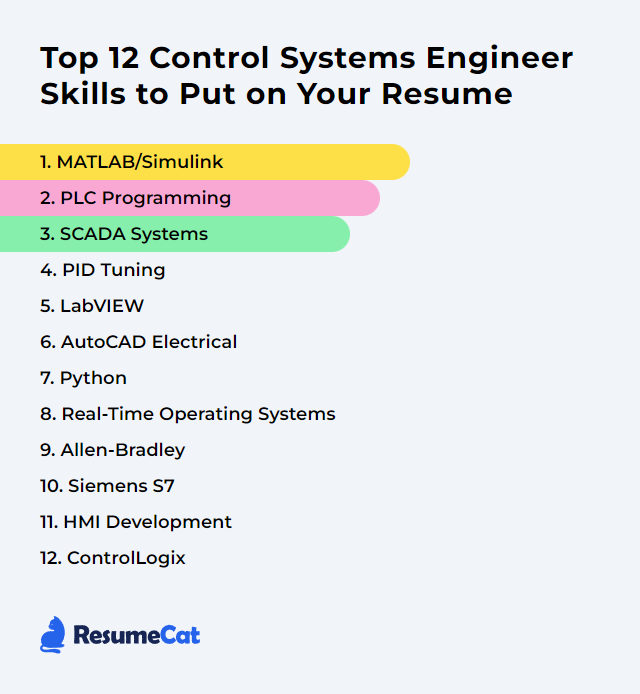
Control Systems Engineer Skills
- MATLAB/Simulink
- PLC Programming
- SCADA Systems
- PID Tuning
- LabVIEW
- AutoCAD Electrical
- Python
- Real-Time Operating Systems
- Allen-Bradley
- Siemens S7
- HMI Development
- ControlLogix
1. MATLAB/Simulink
MATLAB/Simulink is a software platform used by control systems engineers for modeling, simulating, and analyzing dynamic systems. MATLAB offers a programming environment for algorithm development, data analysis, and visualization, while Simulink provides a graphical editor for modeling and simulating control systems, signal processing systems, and other dynamic systems through block diagrams. Together, they facilitate the design, testing, and implementation of complex control strategies and systems.
Why It's Important
MATLAB/Simulink is crucial for a Control Systems Engineer because it provides a comprehensive environment for designing, simulating, and analyzing dynamic systems and control algorithms, enabling rapid development and testing of complex control strategies.
How to Improve MATLAB/Simulink Skills
Improving your MATLAB/Simulink skills, especially as a Control Systems Engineer, involves a multifaceted approach focusing on understanding core concepts, practicing model-based design, and leveraging resources for continuous learning:
Master the Basics: Ensure a strong grasp of MATLAB and Simulink fundamentals. MATLAB's official documentation and Simulink user guide are excellent starting points.
Learn Control Systems Toolbox: Dive into the Control System Toolbox for MATLAB, which offers algorithms and apps for systematically analyzing, designing, and tuning linear control systems.
Explore Simulink Control Design: Use Simulink Control Design to automatically tune PID controllers, design compensators using Bode plots, and more directly within Simulink models.
Practice with Real-World Examples: MATLAB Central's File Exchange offers community-contributed scripts and models, while MATLAB Cody presents challenges that can sharpen your skills.
Utilize Online Courses and Tutorials: Engage with online courses and tutorials specifically tailored for control systems in MATLAB/Simulink. Coursera, Udemy, and MathWorks itself offer specialized courses.
Join Community Forums: Participate in forums like MATLAB Central’s MATLAB Answers to ask questions, share knowledge, and stay updated on best practices.
Implement Projects: Apply your knowledge to real-world projects or simulations. This practical experience is invaluable for understanding complex concepts and discovering innovative solutions.
Stay Updated: MATLAB and Simulink are continuously updated. Keep abreast of the latest features and updates through the MathWorks blogs and release notes.
By combining these resources with regular practice and real-world application, you can significantly enhance your MATLAB/Simulink capabilities as a Control Systems Engineer.
How to Display MATLAB/Simulink Skills on Your Resume
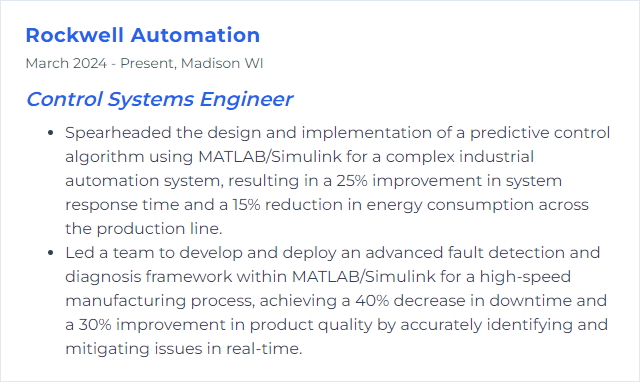
2. PLC Programming
PLC programming involves creating and implementing software logic on Programmable Logic Controllers (PLCs) to automate industrial and manufacturing processes. It enables control, monitoring, and troubleshooting of machinery and process flows in various industries.
Why It's Important
PLC programming is crucial for a Control Systems Engineer as it enables the automated control and monitoring of machinery and processes, ensuring efficiency, reliability, and safety in industrial environments.
How to Improve PLC Programming Skills
Improving PLC programming skills involves continuous learning and practice. Here are concise tips along with relevant resources:
Understand the Basics: Ensure a strong foundation in PLC operations, ladder logic, and other programming languages such as Structured Text (ST) or Function Block Diagram (FBD). PLC Academy offers a good starting point.
Learn from Real-world Projects: Apply your knowledge to real-world scenarios or simulated projects. Websites like PLCdev provide resources and project ideas.
Stay Updated with Industry Standards: Familiarize yourself with industry standards such as IEC 61131-3. The International Electrotechnical Commission website is a valuable resource.
Use Simulation Software: Before implementing, test your programs with simulation software. PLCSim by Siemens is a popular choice.
Join Forums and Online Communities: Engage with other professionals through forums like PLCTalk to share knowledge and solve problems collaboratively.
Continuous Learning: Enroll in advanced courses and certifications. Udemy and Coursera offer courses that range from beginner to advanced levels.
Practice, Practice, Practice: The more you code, the better you get. Set aside time regularly to program, debug, and refine your skills.
By following these steps and utilizing the provided resources, you can significantly improve your PLC programming skills as a Control Systems Engineer.
How to Display PLC Programming Skills on Your Resume

3. SCADA Systems
SCADA (Supervisory Control and Data Acquisition) systems are centralized systems used by control systems engineers to monitor and control industrial processes remotely. They gather real-time data from sensors and equipment across various locations, allowing for efficient process control, data analysis, and timely decision-making to ensure system reliability and performance.
Why It's Important
SCADA systems are crucial for Control Systems Engineers as they provide real-time data acquisition, monitoring, and control over industrial processes and infrastructure, enhancing efficiency, reliability, and safety.
How to Improve SCADA Systems Skills
Improving SCADA (Supervisory Control and Data Acquisition) systems involves enhancing their reliability, security, and efficiency. Here's a concise guide for a Control Systems Engineer:
Enhance Security: Introduce advanced cybersecurity measures to protect against cyber threats. Implement secure communication protocols and regular security audits. ISA offers guidelines on industrial cybersecurity.
Update System Architecture: Migrate to open and modular architectures to improve flexibility and interoperability. The OPC Foundation provides standards for open connectivity.
Improve Data Management: Utilize high-performance databases and implement efficient data logging and analysis tools. Consider InfluxDB for time-series data handling.
Adopt Edge Computing: Process data near its source to reduce latency and network load. Explore EdgeX Foundry for an open-source framework.
Implement Redundancy: Ensure system reliability through redundant hardware and network paths to avoid single points of failure.
Regular Training: Keep staff updated with the latest SCADA technologies and best practices through continuous training. ISA offers a range of training courses.
Upgrade to IoT and Cloud Technologies: Utilize IoT devices for better data collection and cloud platforms for scalability. AWS IoT provides comprehensive IoT services.
Enhance User Interfaces: Develop intuitive and user-friendly interfaces for efficient monitoring and control. Ignition by Inductive Automation offers flexible SCADA solutions with modern UI/UX.
Regular Maintenance and Updates: Ensure the system is up-to-date with the latest software patches and hardware upgrades.
By focusing on these areas, Control Systems Engineers can significantly improve the performance and security of SCADA systems.
How to Display SCADA Systems Skills on Your Resume

4. PID Tuning
PID tuning involves adjusting the proportional (P), integral (I), and derivative (D) control gains of a PID controller to achieve optimal system performance, such as minimal overshoot, fast settling time, and steady-state error. This process ensures the control system responds efficiently and accurately to disturbances or setpoint changes.
Why It's Important
PID tuning is crucial for optimizing the performance of control systems by adjusting the proportional, integral, and derivative parameters to achieve swift, stable, and accurate response to disturbances, minimizing overshoot, settling time, and steady-state error, thus ensuring system reliability and efficiency.
How to Improve PID Tuning Skills
Improving PID tuning involves systematically adjusting the Proportional (P), Integral (I), and Derivative (D) gains to achieve the desired control system performance. Here’s a concise guide:
Understand the Process: Grasp the dynamics of the system you're controlling. Knowing the response characteristics is crucial for effective tuning.
Start with Manual Tuning: Begin with setting I and D terms to zero. Increase the P term until you observe steady oscillations in the output. This establishes a baseline for further adjustments.
Increment Integral Term: Slowly increase the I term to eliminate steady-state error. Be cautious, as too high an I term can lead to instability.
Adjust Derivative Term: Finally, adjust the D term to reduce overshoot and improve response time. The D term is sensitive, so minor adjustments can have significant effects.
Use Software Tools: Leverage PID tuning software and simulation tools for analysis and fine-tuning. They can simulate different conditions, helping you find optimal settings faster.
Iterate: PID tuning is iterative. Repeat the process as necessary, especially if the system dynamics change.
Learn from Resources: Expand your knowledge and stay updated with best practices.
- Control Guru - Practical PID tuning guidance and advanced strategies.
- PID Tuning Guide - A comprehensive online resource for learning and applying PID tuning techniques.
Remember, the goal of PID tuning is to find the best compromise between response time, stability, and steady-state error for your specific application.
How to Display PID Tuning Skills on Your Resume
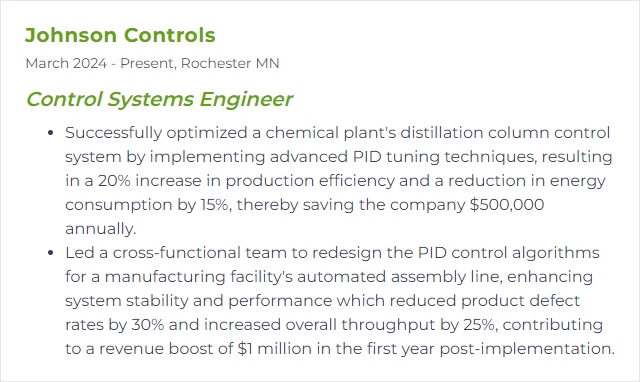
5. LabVIEW
LabVIEW (Laboratory Virtual Instrument Engineering Workbench) is a graphical programming environment used by control systems engineers for developing automated tests, measurement systems, and control applications through intuitive graphical icons and wires that resemble a flowchart.
Why It's Important
LabVIEW is important for a Control Systems Engineer because it provides a powerful, versatile platform for designing, simulating, and implementing control systems through an intuitive graphical programming environment, significantly reducing development time and enabling rapid prototyping and deployment of control algorithms.
How to Improve LabVIEW Skills
Improving your skills in LabVIEW, especially from a Control Systems Engineer perspective, involves a focused approach on mastering data acquisition, signal processing, and real-time control design. Here are concise strategies with resources:
Learn the Basics Thoroughly: Start with National Instruments' (NI) own resources to get a solid foundation. LabVIEW Basics provides an excellent starting point.
Master Data Acquisition and Signal Processing: Dive deep into how LabVIEW can be used for effective data acquisition and signal processing, crucial for control systems. The Data Acquisition Using LabVIEW guide is a practical resource.
Understand LabVIEW Real-Time Module: For real-time control tasks, mastering the Real-Time Module is essential. Explore Real-Time Module Features to learn how to implement deterministic control algorithms.
Participate in LabVIEW Community and Forums: Engage with the LabVIEW Community to learn from others' experiences, share your challenges, and get your questions answered by both peers and experts.
Pursue Advanced LabVIEW Training and Certification: Consider undergoing more advanced training and obtaining certifications such as CLAD, CLD, or CLA, which will deepen your understanding and credibility. Check LabVIEW Certification for details.
Practice by Building Projects: Apply your skills in real-world projects or simulations related to control systems. This will help you understand the nuances and challenges firsthand. Project inspiration can be found through community forums or the LabVIEW MakerHub.
Stay Updated with LabVIEW Versions: New features and improvements are regularly added to LabVIEW. Keep your software updated and explore what's new with each release. Visit the LabVIEW Release Notes for the latest updates.
By focusing on these areas and leveraging the resources provided, you can significantly improve your LabVIEW skills as a Control Systems Engineer.
How to Display LabVIEW Skills on Your Resume
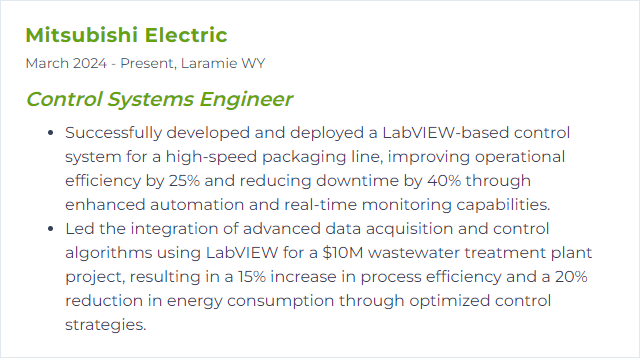
6. AutoCAD Electrical
AutoCAD Electrical is a specialized software tool developed by Autodesk, designed for electrical control systems engineers. It facilitates the creation, modification, and documentation of electrical control systems designs, offering a comprehensive library of symbols and tools for automating electrical design tasks, enhancing productivity and accuracy in the design of wiring, circuitry, and control panels.
Why It's Important
AutoCAD Electrical is crucial for Control Systems Engineers because it streamlines the creation and modification of electrical control systems designs, enhancing accuracy, productivity, and collaboration, while ensuring compliance with industry standards.
How to Improve AutoCAD Electrical Skills
To improve your proficiency and efficiency in AutoCAD Electrical as a Control Systems Engineer, consider the following concise strategies:
Utilize Templates: Start your projects with templates that are specifically designed for control systems. This saves time and ensures consistency. Autodesk provides a basic guide to get you started.
Learn Keyboard Shortcuts: Familiarize yourself with AutoCAD Electrical keyboard shortcuts to speed up your design process. Autodesk offers a comprehensive list, which can be found here.
Customize Your Tool Palette: Tailor the tool palette to better suit control systems design. This customization allows for quicker access to frequently used commands and tools. Learn how to customize it from Autodesk’s official support page.
Use the Circuit Builder for Smart Design: Employ the Circuit Builder for designing complex control systems, enabling smarter, rules-based designs. Autodesk’s Circuit Builder tutorial offers guidance on using this feature effectively.
Stay Updated with Training and Resources: Continuously update your skills through Autodesk’s training and events and leverage online forums and communities for tips and troubleshooting.
Automate Repetitive Tasks with Scripts and APIs: Explore the possibility of automating repetitive tasks with AutoLISP or .NET. Autodesk’s developer network provides resources for those looking to customize and automate their workflow.
By following these strategies and leveraging Autodesk’s extensive resources, you can significantly improve your efficiency and effectiveness in AutoCAD Electrical for control systems engineering.
How to Display AutoCAD Electrical Skills on Your Resume

7. Python
Python is a high-level, versatile programming language widely used for developing control algorithms, data analysis, and automation scripts in control systems engineering.
Why It's Important
Python is important for a Control Systems Engineer because it offers powerful libraries (like NumPy, SciPy, Matplotlib) for mathematical modeling, simulation, and visualization, enabling efficient design, analysis, and testing of control systems.
How to Improve Python Skills
Improving your Python skills as a Control Systems Engineer involves focusing on libraries and concepts that are particularly relevant to control systems, numerical methods, and data analysis. Here are succinct steps with resources to guide you:
Master Core Python: Understand Python's data structures, functions, and classes. Focus on writing clean and efficient code. Python Official Tutorial.
NumPy and SciPy: Learn these libraries for numerical and scientific computing. They are essential for handling arrays and performing complex mathematical operations. NumPy | SciPy.
Matplotlib and Seaborn: Gain proficiency in these libraries for data visualization, crucial for analyzing and presenting data effectively. Matplotlib | Seaborn.
Pandas: Understand Pandas for data manipulation and analysis, especially useful for handling time series data common in control systems. Pandas.
Control Systems Library: Explore the
controllibrary in Python specifically designed for analyzing and designing control systems. Python-Control.SimPy for Simulation: Learn SimPy for discrete-event simulation, helpful in modeling complex systems' behavior over time. SimPy.
Improve Problem-Solving Skills: Regularly practice problem-solving on platforms like LeetCode or HackerRank to enhance your algorithmic thinking. LeetCode | HackerRank.
Stay Updated and Collaborate: Follow Python-related forums and platforms (e.g., Stack Overflow, GitHub) to stay updated with the latest trends and collaborate on projects. Stack Overflow | GitHub.
Real-World Projects: Apply your knowledge to real-world projects or simulations relevant to control systems. This could involve automation scripts, data analysis from sensors, or designing control algorithms.
By focusing on these areas and leveraging the provided resources, you can significantly improve your Python skills in a manner that's directly applicable to control systems engineering.
How to Display Python Skills on Your Resume
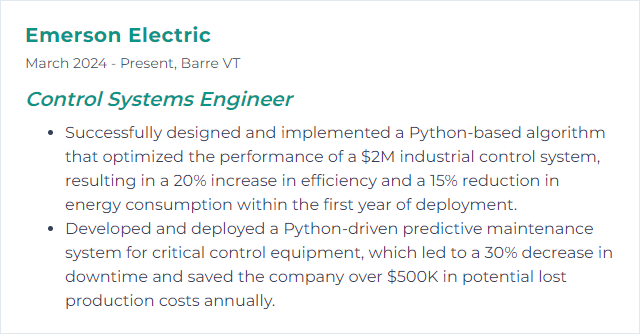
8. Real-Time Operating Systems
Real-Time Operating Systems (RTOS) are specialized operating systems designed to manage hardware resources and execute tasks within strict timing constraints, ensuring predictable, deterministic behavior essential for control systems engineering applications where timing and reliability are critical.
Why It's Important
Real-Time Operating Systems (RTOS) are crucial for Control Systems Engineers because they ensure timely and deterministic responses to sensor inputs or external events, critical for maintaining stability, safety, and efficiency in automated and control systems.
How to Improve Real-Time Operating Systems Skills
Improving Real-Time Operating Systems (RTOS) for Control Systems Engineers involves enhancing performance, reliability, and response times. Here are concise strategies:
Optimize Task Scheduling: Implement efficient scheduling algorithms like Rate Monotonic (RM) or Earliest Deadline First (EDF) to improve task prioritization and ensure timely task execution. More on Task Scheduling.
Reduce System Latency: Minimize interrupt latency and context switch times by optimizing interrupt service routines (ISRs) and utilizing fast, deterministic mechanisms for task switching. Understanding System Latency.
Memory Management Enhancements: Use fixed-size memory allocation and avoid dynamic memory allocation to reduce fragmentation and improve memory access times. Memory Management in RTOS.
Use of Middleware: Implement RTOS-compatible middleware for standardized communication and I/O operations, reducing development time and improving system reliability. RTOS Middleware.
System Tuning: Continuously monitor system performance and resource utilization to identify bottlenecks. Adjust task priorities and system configurations based on real-time data. RTOS Performance Tuning.
Implement Real-Time Analysis Tools: Utilize tools for tracing and analyzing system behavior in real-time to identify and resolve timing issues. RTOS Analysis Tools.
Software Quality and Testing: Employ rigorous testing methods, including unit testing, integration testing, and stress testing, to ensure software reliability and adherence to real-time constraints. Software Testing in RTOS.
By focusing on these areas, Control Systems Engineers can enhance the performance and reliability of RTOS-based systems, ensuring they meet the stringent requirements of real-time applications.
How to Display Real-Time Operating Systems Skills on Your Resume
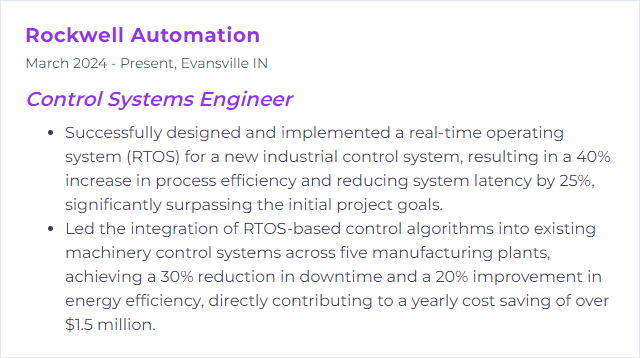
9. Allen-Bradley
Allen-Bradley is a brand name of industrial automation and control products, including programmable logic controllers (PLCs), human-machine interfaces (HMIs), and other related equipment, owned by Rockwell Automation. It is widely used by control systems engineers for designing, implementing, and maintaining automation systems.
Why It's Important
Allen-Bradley is important for a Control Systems Engineer because it is a leading brand in industrial automation and control products, including PLCs, HMI, sensors, and safety components, offering reliable and innovative solutions that are widely used in various industries for designing, implementing, and maintaining advanced control systems.
How to Improve Allen-Bradley Skills
Improving your skills with Allen-Bradley products, a prominent brand in the field of industrial automation and control systems, involves a combination of theoretical knowledge and practical experience. Here’s a concise guide for a Control Systems Engineer:
Familiarize Yourself with Rockwell Automation: Start by exploring the Rockwell Automation website, the parent company of Allen-Bradley. It offers an extensive range of resources, from product information to training courses.
Enroll in Training Courses: Invest in official training programs through Rockwell Automation Training Services. Courses cover topics from basic introductions to advanced system maintenance and troubleshooting.
Utilize Online Forums and Communities: Engage with the PLCtalk.net forum, a valuable resource for real-world advice, troubleshooting tips, and best practices shared by professionals and enthusiasts.
Practice with Real Hardware or Simulators: Hands-on experience is crucial. If access to physical hardware is limited, consider software simulators like RSLogix Emulate for practicing programming and debugging without the need for actual PLC hardware.
Study Manuals and Documentation: Deep dive into manuals and product documentation available on the Rockwell Automation Literature Library. Understanding technical details and specifications can significantly improve your ability to design and troubleshoot systems.
Keep Up with New Technologies and Updates: Technology evolves rapidly. Stay updated with the latest Allen-Bradley products and software updates by regularly checking the Rockwell Automation Product Compatibility and Download Center.
Network with Other Professionals: Join LinkedIn groups or attend industry conferences and workshops. Networking with other professionals can provide insights into industry trends, challenges, and innovative solutions.
By combining these strategies, you can significantly improve your proficiency with Allen-Bradley products and systems, enhancing your capabilities as a Control Systems Engineer.
How to Display Allen-Bradley Skills on Your Resume
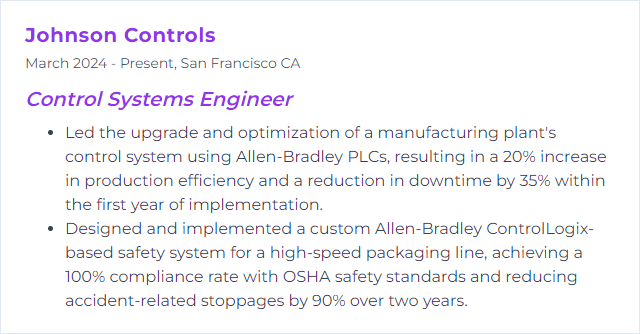
10. Siemens S7
Siemens S7 is a family of programmable logic controllers (PLCs) used for industrial automation and control systems, offering scalable hardware and software for various application needs.
Why It's Important
Siemens S7 PLCs are crucial for Control Systems Engineers due to their widespread use in industrial automation, offering robust performance, flexibility in programming, and compatibility with a wide range of applications, thereby enabling effective and efficient control and monitoring of complex processes.
How to Improve Siemens S7 Skills
Improving Siemens S7 performance and efficiency involves a few strategic steps. Here's a concise guide:
Optimize Code: Streamline your PLC program. Use efficient blocks and minimize scan cycle time. Focus on optimizing data blocks and reducing unnecessary operations. Siemens Support offers guidelines and best practices.
Update Firmware: Ensure your S7 PLC and related components are running the latest firmware versions for enhanced features and bug fixes. Firmware updates can be found on the Siemens Industry Online Support page.
Network Optimization: Minimize network traffic by structuring your communication tasks efficiently. Use PROFINET features like IRT for real-time applications. The PROFINET System Description provides comprehensive details.
Regular Maintenance: Perform routine checks and diagnostics to prevent issues. Siemens provides diagnostic functions within their TIA Portal and S7 software for this purpose. Check the TIA Portal page for tools and updates.
Training and Resources: Enhance your knowledge and skills through Siemens' training courses and resources. Continuous learning helps in leveraging advanced features of the S7 series. Explore available courses on the Siemens SITRAIN website.
Utilize Advanced Features: Make use of the advanced features and functions provided by the S7 series, such as predictive maintenance, energy management, and integrated safety features. The Siemens Industry Services page offers insights into these functionalities.
Engage with Community: Join Siemens forums and communities to share insights, ask questions, and get advice from experienced professionals. The Siemens Industry Community is a valuable resource.
Implementing these strategies can significantly improve the performance and efficiency of your Siemens S7 systems.
How to Display Siemens S7 Skills on Your Resume

11. HMI Development
HMI Development involves designing and implementing Human-Machine Interfaces (HMIs) that allow operators to interact effectively with control systems, enabling monitoring, managing, and visualizing the operational processes of machinery or plant environments.
Why It's Important
HMI (Human-Machine Interface) development is crucial for Control Systems Engineers as it enables efficient, intuitive interaction between operators and complex control systems, enhancing operational safety, productivity, and system diagnostics.
How to Improve HMI Development Skills
Improving HMI (Human-Machine Interface) development involves focusing on user experience, system functionality, and effective communication between the operator and the control system. As a Control Systems Engineer, consider these concise tips:
User-Centered Design: Start with understanding the operator's needs and workflows. Incorporate user feedback early and throughout the development process to ensure the interface meets their requirements. Nielsen Norman Group offers insights on user-centered design principles.
Simplicity and Clarity: Design for clarity and ease of use. Use simple, intuitive layouts and controls. Minimize cognitive load by displaying only necessary information. Interaction Design Foundation provides guidelines on achieving simplicity in design.
Consistency: Ensure consistent use of symbols, color coding, and terminology throughout the HMI. This enhances learnability and reduces errors. UX Design Institute explores the importance of consistency in design.
Feedback and Responsiveness: Implement clear, immediate feedback for user actions to convey system status and facilitate effective control. Smashing Magazine discusses integrating user feedback into the design process.
Accessibility: Design interfaces that are accessible to all users, including those with disabilities. Incorporate accessibility guidelines from the start. Web Accessibility Initiative (WAI) outlines basic principles of web accessibility that can be adapted for HMI.
Security: Prioritize security in HMI design to protect against unauthorized access and ensure safe operation. ISA/IEC 62443 series standards provide a framework for industrial automation and control systems security.
Testing and Iteration: Conduct thorough testing with real users in realistic scenarios. Use the feedback to refine and improve the HMI. Iterative design allows for continuous improvement. Usability.gov offers methods and strategies for usability testing.
By applying these principles, Control Systems Engineers can develop more effective, efficient, and user-friendly HMIs.
How to Display HMI Development Skills on Your Resume
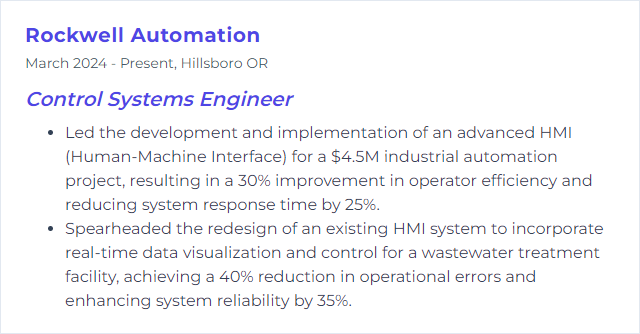
12. ControlLogix
ControlLogix is a modular, programmable automation controller (PAC) system designed by Allen-Bradley (Rockwell Automation) for industrial applications, offering advanced control, communication, and I/O capabilities for a wide range of control system requirements.
Why It's Important
ControlLogix, developed by Allen-Bradley, is crucial for a Control Systems Engineer because it offers a powerful, scalable platform for industrial automation, enabling precise control, data handling, and integration across complex machinery and processes, enhancing efficiency, reliability, and system interoperability.
How to Improve ControlLogix Skills
Improving ControlLogix performance involves several strategies focused on optimizing system design, programming efficiency, and hardware utilization. Here are concise recommendations for a Control Systems Engineer:
Streamline Logic: Optimize your ladder logic or structured text to reduce scan time. Use efficient instructions and avoid complex, nested routines. Rockwell's Best Practices
Optimize Data Handling: Structure your data efficiently, using arrays and UDTs (User-Defined Types) wisely to minimize overhead. Data Structuring Guide
Network Optimization: Ensure your network infrastructure (Ethernet/IP) is optimized for traffic and segment control networks appropriately. Use managed switches and proper QoS (Quality of Service) settings. Network Design Considerations
Use Produced and Consumed Tags Sparingly: These can increase network load and scan time if overused. Implement them judiciously for critical real-time data exchange. Produced and Consumed Data
Firmware Updates: Regularly update your ControlLogix firmware to benefit from performance improvements and bug fixes. Firmware Updates
I/O Configuration: Use I/O configurations that minimize latency. For critical applications, consider using local I/O or direct connection methods over networked I/O solutions. I/O Configuration Best Practices
Monitor System Performance: Utilize built-in diagnostics and performance tools in Studio 5000 to identify bottlenecks and areas for improvement. Diagnostics and Troubleshooting
Training and Resources: Continuously seek out training opportunities and resources to stay updated on best practices and new features. Rockwell Automation Training
By focusing on these areas, a Control Systems Engineer can significantly enhance the efficiency, reliability, and performance of ControlLogix systems.
How to Display ControlLogix Skills on Your Resume
